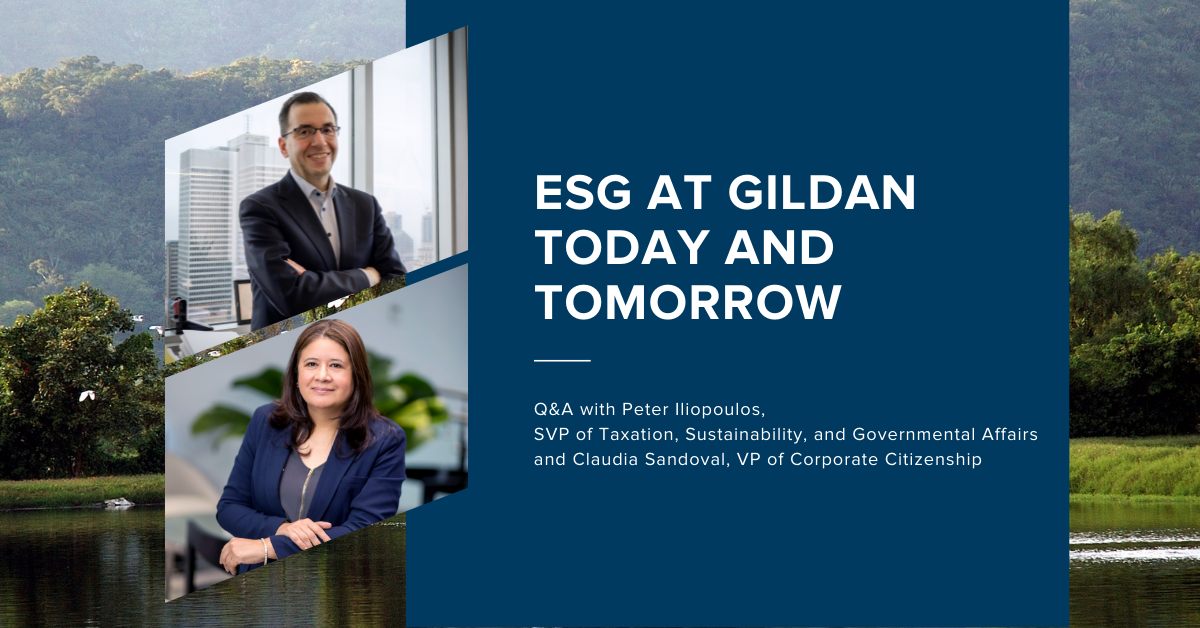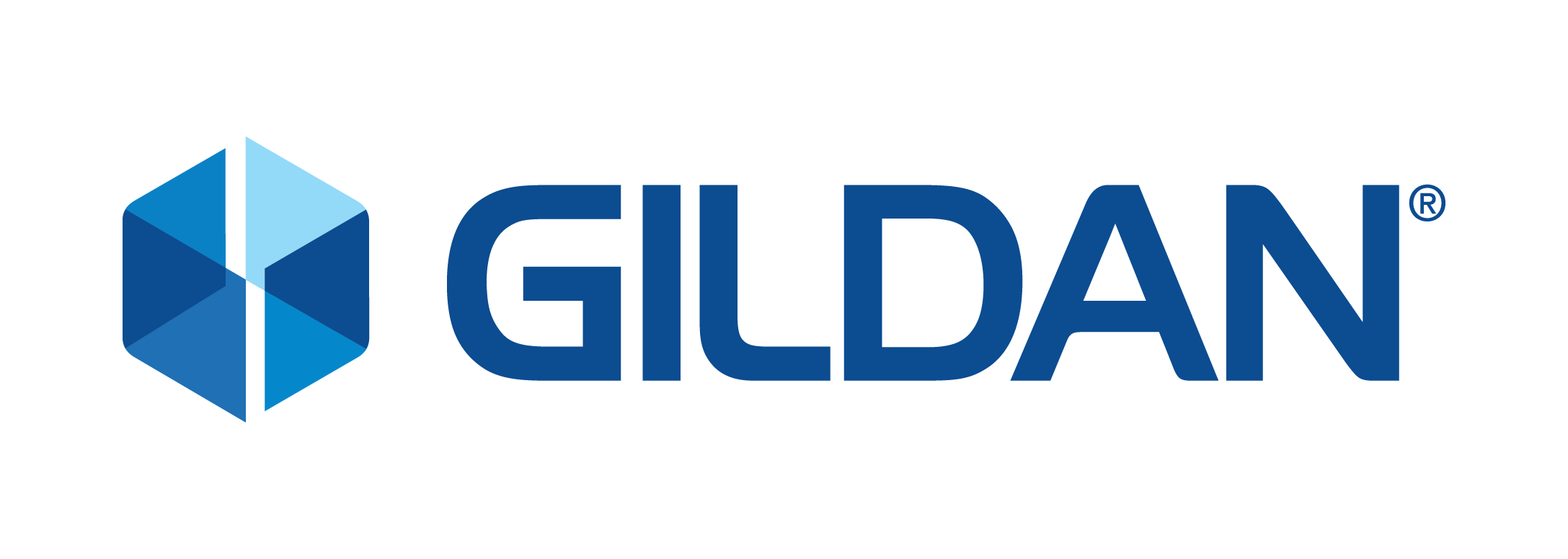Q&A With Executives: ESG at Gildan Today and Tomorrow

Since 2002, Gildan's sustainability program has helped guide its business operations in all areas related to integrating Environmental, Social, and Governance (ESG) practices into its long-term business strategy. Read as Peter Iliopoulos, Senior Vice President of Taxation, Sustainability, and Governmental Affairs at Gildan, and Claudia Sandoval, Vice President of Corporate Citizenship at Gildan, share their thoughts on the Company's ESG program today and how the organization plans to accelerate ESG in the future.
As an apparel company, what are the ESG areas you are most focused on?
Peter: We prioritize our focus on the most material areas of our business from an ESG perspective, and where we know we can make an impactful difference. For example, on the environmental side, water usage is a big part of our manufacturing process. Water is a precious commodity, and it is the single most significant resource we use. It's imperative that we understand our water use, continue to find innovative ways to reduce and reuse water in our operations, and work with local communities throughout the process. Our approach to wastewater treatment in Honduras and the Dominican Republic, where we have developed a Biotop lagoon system, is a great example of this.
Also, while we recognize that climate change is not a risk that is just emerging – we have been monitoring and assessing climate change risks on our business and communities for many years – it remains an important area of focus especially given that cotton is a key raw material input in the manufacturing of our products. In this regard, we are analyzing various scenarios, including what a global temperature permanent shift of 1, 2, or 3 degrees warmer would mean to cotton crops. We are developing scenarios for this and working with third-party specialists to better understand and set new targets so we can do our part to help address climate change.
Claudia: On the social side, human rights is also a critical issue. The vast majority of our employees work in low and lower-middle-income countries where the regulatory, infrastructure and support systems are not as robust as in other countries. There is increased scrutiny on how companies operate in these environments and how they treat their workers. Here at Gildan, we are committed to going beyond what is required to provide our employees with good wages, health care and benefits, and a safe workplace. We have always recognized that our people are our most valuable asset and are key to our success as a company. We invest in our people not only because it is the right thing to do but also because it makes our business stronger.
Can you elaborate on how ESG is part of the Company's overall business strategy?
Peter: Our business strategy is based on three core pillars: cost competitiveness, capacity-driven growth, and ESG. By design, ESG is a core part of our business strategy and ultimately part of our overall value proposition to our customers of providing the best quality product, at the best possible price, made under the best possible working conditions from both a social and environmental perspective. Evaluating ESG implications is integrated into our key strategic decision-making processes, both from a risk and opportunity perspective. Further, being among the most vertically integrated global manufacturers, with approximately 90% of our sales deriving from products we manufacture, we have direct control of our operations, allowing us to implement industry-leading practices when it comes to ESG.
How do you ensure ESG is integrated into everything you do?
Claudia: Our emphasis on ESG begins at the top, starting with our Board of Directors and the Company's top leadership and is ultimately cascaded through the entire organization. Our ESG responsibility is embedded in the culture of the Company. One great example is how we are developing our "Next Generation" ESG strategy. We didn't want this to be something created by a small corporate team working in isolation, so we established five working groups that include representation from every area of the Company and its operations. It is important that everyone has a voice. Everyone knows what others are doing, from our sales and marketing colleagues to our manufacturing teams. Everyone has a chance to provide their diverse perspectives, challenge the norm, and be a part of creating innovative solutions to some very complex problems.
Can you give us a glimpse of Gildan's "Next Generation" ESG strategy?
Peter: Building on our ESG efforts and accomplishments to date, our "Next Generation" ESG strategy will be focused on emerging trends affecting our business and, more broadly, the world. We are taking a future-focused lens to determine where and how to leverage our core competencies to ensure we are engaged in areas where we can have the most meaningful impact. We know from our experience that developing our strategy with these considerations in mind will ensure ESG continues to be a source of competitive advantage for Gildan, ensuring both operational and financial resilience in the long-term. We recognize that we need to continue to raise the bar and go further. We have over 10 years of experience of setting goals and targets and will leverage that experience as well as the results of our latest materiality assessment to take our next strategy and set of targets to the next level.
Additionally, central to our strategy are transparent and meaningful ESG disclosures which, for over 17 years, have continuously evolved as have the needs and expectations of our various stakeholders. That's why this year, while we will continue disclosing our ESG performance in alignment with the GRI, we have also, for the first time reported in accordance with the standards set by SASB. As we also recognize the need for transparent and decision-useful specific climate-related information, we have begun implementing the Financial Stability Board's recommendations. Over the next few years, we plan to take steps towards the full implementation of TCFD disclosures.
Claudia: Our new strategy will be a continuation of our journey – where there is no end but rather a need to continue to evolve. While we embarked on our ESG journey decades ago, we recognize there is work still to be done, and we continue to grow and learn. We see an opportunity to strengthen what we currently have and the increased expectations and scrutiny around ESG matters. We know that it is not enough to set a target, and, therefore, we are developing clear and credible roadmaps to address the challenges and opportunities we face. As Peter said in the beginning, we are focusing on what really matters to our business.

